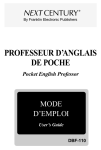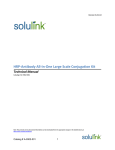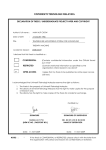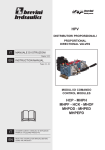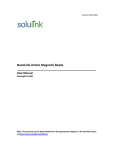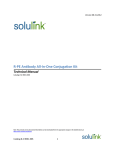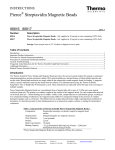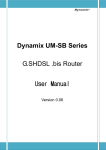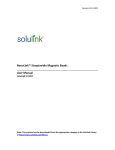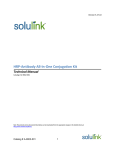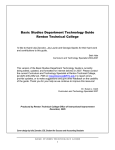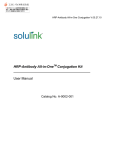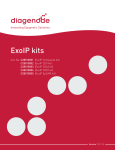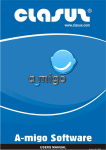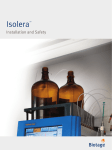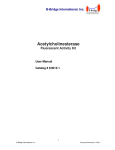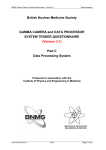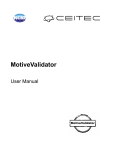Download MAGNETIC BEADS
Transcript
FAQ Database (February 2011) • • • • MAGNETIC BEADS ANTIBODY LABELING KITS CROSSLINKING KITS AND REAGENTS MISCELLANEOUS MAGNETIC BEADS Tell me about the types of beads that you offer? We currently offer two different types of magnetic beads; NanoLink™ is a less-uniform bead mixture which has 150 and 800 nm diameter beads, and MagnaLink™ is a very uniform bead with a 2.8 µm diameter. Both bead types are made with magnetite encapsulated by a non-styrene polymer surface. Unless you are particularly concerned with uniformity (e.g., for NMR, flow cytometry, etc.) the NanoLink™ beads are particularly suited for high-capacity capture of oligos, peptides, and antibodies. Both bead types come in three different varieties; streptavidin coated, 4FB linker coated, and amine coated. As a custom service, we can get other bead types for you, and link them to 4FB or streptavidin. And, we can add a linker with an extended spacer, but currently offer only streptavidin-coated, 4FB-coated, and amino beads as catalog products. NanoLink™ Bead size: bimodal (non-uniform) distribution (~150 nm to ~800 nm) Density : 1.5 g/cm3 Magnetite content (Fe3O4): 40% (w/w) Magnetic moment: 25 emu/g (electromagnetic units per gram) MagnaLink™ Bead size; 2.8 micron (uniform distribution) Density : 1.9 g/cm3 Magnetite content (Fe3O4): 50% (w/w) Magnetic moment: N/A What are the advantages of using high biotin binding capacity beads? Higher binding capacity means greater capture using less bead mass. Less bead mass for your immobilization assays results in better assay capture and increased savings. Why do you offer 2 sizes of beads. Which one do I choose? We have 2 sizes of beads to fit the needs of specific applications. Some customers need a uniform sized bead. The MagnaLink™ beads offer this. For MOST applications however, this is not necessary. Some microarray applications might require a certain size as well. The larger bead will settle faster if that might be an issue in your application. Will unlabeled DNA bind nonspecifically to NanoLink™ streptavidin beads? Random DNA sequences may bind to the surface of the magnetic beads, but only very weakly, if at all. The non-biotinylated sequences can easily be washed away from the beads. The crosslinked streptavidin doesn't prevent binding. How do I ensure that all of my beads become labeled with biotinylated biomolecules? All of the beads should be attached to antibody if you use a 10 to 20-fold molar excess of biotinylated product. Washing away unbound antibody is straightforward – you can magnetize the beads and wash them to remove unbound antibody. You can repeat this a few times, it is not trivial to remove any unbound beads from bound beads. Will NanoLink™ streptavidin beads experience less nonspecific binding (NSB) of biotinylated nucleic acids or biotinylated proteins than other beads? We DO think that our NanoLink™ streptavidin-coated beads might provide you with lower nonspecific protein binding to your biotinylated biomolecule (compared to competing products) for 2 reasons. (1) Because of the highly crosslinked streptavidin (using our unique, patented chemistry) there is less polymer surface area on the bead exposed for proteins or nucleic acids to adhere to. This in itself should reduce NSB for you. Our extensively crossliked streptavidin is the reason the biotin binding capacity of these beads is so high. (2) And…because of the high biotin binding capacity, you can use FEWER beads in your assay…again reducing nonspecific protein binding. Do I need to block my beads? How? Depending on your application, Solulink recommends blocking streptavidin beads. If you are capturing nonphosphorylated proteins we recommend blocking with Bead Blocking Solution (Cat. No. S-4023-025). If you are capturing DNA or RNA, we recommend blocking with yeast tRNA, salmon sperm, or herring sperm DNA at 10 mg/mL, if the presence of blocking DNA or RNA are not a factor in your downstream application. Some bead manufacturers use beads that are blocked. Are blocked beads better to use? Many researchers do not want blocked beads because the blocking protein can and does leach some. Not much but some. It is not covalently linked, so some leaching occurs. Some researchers do not want any protein leaching since this would interfere, for example, with protein sequencing and the specificity of the beads in their particular application. Other researchers require low nonspecific binding with very high binding capacity and don't care about leaching. These researchers do want a blocked bead. If one is going to capture biotinylated DNA, you probably don’t need blocked beads. pH and detergents turn out to be more important factors for reducing DNA-based NSB than any other factors. If one is going to capture biotinylated antibody or proteins, one should block the beads for optimal results and minimal NSB. For some applications, pre-blocked beads would be a good thing, and for others, not needed. Regarding reduction of binding capacity using blocked beads…experiments we have done indicate that binding capacity is reduced for antibodies. But the reason for this is because 15% of the binding is NSB to begin with, and not related to biotin/streptavidin interactions. Even after extensive casein blocking, our NanoLink™ Streptavidin beads still bind 250 µg of biotinylated IgG vs. 80 µg for Invitrogen’s product (based on their website) per mg. So after blocking, we still bind 3X more antibody than anybody else. Without blocking, we capture a great deal more biotinylated IgG, but this increased capture is nonspecific binding. I believe that we have captured up to 400 µg of biotinylated IgG per mg of NanoLink™ without blocking the beads first. So yes, you will see a reduction in binding of biotinylated proteins, but this reduction is not due to loss of streptavidin, but rather blocking of NSB binding sites. Can I use BSA as a bead block instead of casein? The composition of our bead blocking solution is: 5 mg/mL Hammarsten-grade casein in 25 mM Tris, 150 mM NaCl, pH 7.4 containing 600 ppm Kathon anti-microbial agent and 0.05% anti-foam A. You CAN use BSA in place of casein, but sometimes BSA may contain a small amount of biotin, which will bind to the SA. If BSA is not a problem with any of your downstream applications, then yes, it should be fine to use this as a blocking agent. Can NanoLink™ 4FB beads work at high temperatures (like 45ᵒC), with HyNic-modified oligos? The 4FB magnetic microspheres are designed to work for Hynic-modified, small biomolecules (such as oligos and peptides). You can certainly use the 4FB magnetic microspheres in conjunction with the Hynic modified oligos or Hynic-modified peptides. The 4FB microspheres work fine at temperatures of 45ᵒC. You can even go up to 60ᵒC for up to five minutes and still have good stability. The Hynic oligo is not very stable due to polymerization, therefore we do not recommend that you use high temperatures on the Hynic modified oligo by itself, but once it is reacted with the 4FB, the bis aryl hydrazone oligo is very stable in temperatures up to 94ᵒC. When looking at NanoLink™ Streptavidin beads under a microscope, I see a significant amount of clumping, of aggregates, some being 20X larger than a single bead. Are the beads OK to use? We have sometimes noticed aggregation with NanoLink™ SA beads, but have recently (Nov 2010) modified our SOP to greatly reduce clumping issues. This can occur from the way the beads are prepared and the SA crosslinked. If you have a sonicator available, you might try performing a 1 minute sonication to disrupt aggregates. After a 30–60 sec sonication treatment, there was very little clumping observed, mostly single beads. Since the beads are very concentrated to begin with (10 mg/mL), the recommendation is that once diluted, that you sonicate your sample for 30–60 sec prior to your application. Beads obtained after November 2010 should experience very little clumping. Magnetic beads - blocking buffers, elution conditions, and resolving clumping issues. Blocking Buffers: For immobilization of proteins, we recommend using a casein buffer. We have a bead block buffer available (Cat. No. S-4023-025). Elution conditions: We recommend using a glycine buffer (pH 2.8) for elution. You should collect the antigen in a neutral phosphate buffer, to limit exposure to the harsh pH conditions. Clumping Solutions: To obtain a mono-disperse population of NanoLink™ Streptavidin beads, these procedures will help: 1. Vortex the beads for 1 minute in their original container to resuspend the pellet. 2. Remove a 10 µL aliquot (mass equivalent to 100 µg of beads) from the dispersed suspension using a P10 pipette. Add the aliquot directly into a previously prepared solution of 1 M NaCl containing 1% Tween-20 and gently pipette up and down several times to disperse the beads while avoiding foam. 3. Immerse the tube containing the beads into a water bath sonicator (e.g., Branson 1200, 120 volts 50-60 Hz) for three min. 4. Remove a small aliquot of the beads and place them on a standard light microscope (e.g., 100X to 400X) to confirm monodispersity. 5. Once monodisperse, the beads can be washed twice (with a magnet) using molecular grade water. (Note: once the beads are monodisperse, they take a lot longer to pull them to the walls of the tube using a magnetic field (up to two full min). 6. Once the beads are monodisperse, they can be placed into any other suitable buffer you wish with or without Tween-20 and the majority of the population will remain monodisperse. Over time, (for example overnight), the beads will begin to reform aggregates due to the nature of streptavidin itself. This cannot be helped. Important comments and notes: 1 M NaCl containing 1% Tween-20 combined with sonication does not adversely affect the biotin binding capacity of the NanoLink™ beads. Do not attempt to sonicate or disperse larger masses of beads at one time or in a larger volume. Attempts to disperse the entire volume of beads or even a smaller volume such as 100 µL beads (1 mg) at a single time is not effective. A large amount of sonication energy must be focused on a small volume and mass of beads (e.g., 100 µg in 100 µL) to fully re-disperse the beads into their mono-disperse state. Never use SDS at any concentration in an attempt to disperse the beads since this abolishes their biotin binding capacity. Can NP-40 detergent be used with Solulink’s NanoLink streptavidin beads? We have never used NP-40 with our streptavidin beads; nevertheless, this detergent should be completely compatible with our beads. The literature is full of references in which NP-40 at a final concentration of 0.1% is used to wash streptavidin beads prior to addition of biotinylated molecules. In this regard, our streptavidin beads should be no different and fully compatible with the use of this detergent. The covalent bond used to immobilize streptavidin on the beads is not affected by the presence of this detergent. The only detergent that we definitely know destroys all biotin binding capacity is the denaturing ionic detergent SDS. Can I heat the beads to cleave the biotin/streptavidin bond? As with all streptavidin beads, excessive heating will lead to dissociation of the streptavidin tetramer and leaching of monomeric subunits. We don’t recommend heating the streptavidin beads over 40ᵒC. NanoLink™ Streptavidin beads—what pH range are the beads stable? The beads are stable over a wide pH range, from pH 3 to 9. NanoLink™ Streptavidin beads—have you tested for nonspecific protein adsorption? Not specifically, but we do recommend using a blocking agent such as casein. We sell a bead block for this purpose. NanoLink™ Streptavidin beads—have you tested chemical resistance (to urea, detergents)? We haven’t performed any specific tests, but streptavidin is a pretty stable protein, so concentrations of these reagents that are “protein-friendly” would be fine with regards to the streptavidin-coated beads. Do you have beads for direct binding of antibodies, peptides, or oligos? The NanoLink™ 4FB beads are used for direct binding of HyNic-modified biomolecules. To learn more, please visit the NanoLink™ 4FB product page. Regarding the MagnaLink™ Streptavidin beads, can the amount of biotin bound to the bead be quantitated using a fluorescent tag? Does the bead quench the fluorescence in any way? We routinely quantify the biotin-binding capacity of our beads using fluorescein-biotin. However, since it is very difficult to ascertain the effect of the bead on quantum yield and other properties of the fluor, we avoid this situation by fluorescently quantifying the amount of unbound vs. bound bioin-fluorophore left in solution. By simple subtraction, we obtain the amount bound. If you use this technique, it is always wise to run a control bead without bound streptavidin if possible as well as a no bead control. ANTIBODY LABELING KITS Why use ChromaLink™ Biotin or ChromaLink™ Digoxigenin (DIG) labeling kits? For maximum sensitivity and reproducibility, it is important to avoid over-labeling, which leads to reduced immunoreactivity, or under-labeling, which leads to a weak signal. ChromaLink™ Biotin and DIG Labeling Kits are the only kits which enable quantification of the incorporated label with a simple UV scan of the labeled protein. No more HABA assays. By simply measuring the biotin- or DIG-labeled protein at 280 and 354 nm, and inserting the values into an easy-to-use calculator provided with the kit, you can determine the exact number of biotins or DIG on your antibody (MSR). Consistent, quantifiable labeling provides you with consistent, reliable, and reproducible results in your assays. Can all/any antibodies and/or proteins be labeled with ChromaLink™ reagents? Yes. All proteins and antibodies may be labeled with ChromaLink™ Biotin or DIG labels. These products label primary amino groups on lysines found in proteins. A cysteine-labeling ChromaLink™ biotin reagent is also available (Cat. No. B-1012-105). How do I remove excess biotin from my reaction? If you are using the One-Shot kit or the standard ChromaLink™ kit, this is done in step 6 of the procedure (One-Shot protocol) or the second buffer-exchange step (standard kit) using the Zeba™ spin columns included in the kit. (2nd Buffer Exchange: remove excess labeling reagent) What is the difference between 10X modification buffer and 10X PBS? There is only a minor pH difference between these 2 buffers. 10X Modification Buffer 1.0 M Sodium Phosphate 1.5 M Sodium Chloride pH 7.4 @1X concentration 10X PBS 1.0 M Sodium Phosphate 1.5 M Sodium Chloride pH 7.2 @ 1X concentration I want to label 10 mg of protein with biotin. Suggestions? One should purchase reagents separately to save money. You can purchase 5 mL Zeba columns from Pierce. The 10X Modification Buffer (without azide), is S-4000-005. This is 5 x 1.5 mL for $50. You can get the ChromaLink™ reagent in bulk (5 x 1.0 mg) if preferred, which is B-1007-105 (for the water soluble version) or (10 mg), which is Cat. No. B-1007-010. The best modification conditions: 1. 2. 3. 4. Protein concentration is 5–6 mg/mL. Normally 6X equivalence of linker used, MSR will be 4–4.5. If you want high MSR, just increase to 8X or 10X. The 5 mL Zeba desalt spin column is good for 500–2,000 µL. Use 2.5 mL 1X MB or 1X PBS to pre-equilibrate column at 1,000 x g for 2 min (three times) before desalt (desalt at 1,000 x g for 3 min). Use 15 mL tube as collection tube. Can diluted/reconstituted ChromaLink™ biotin be frozen for storage longer than one day, then reused at a later time? The diluted biotin reagent should NOT be used after 1 day, even if frozen. Should be used fresh, as hydrolysis can occur. The sulfo-ChromaLink™ Biotin reagent is stable for an hour or for the day (at most) if kept at 4oC…but not longer than that. Hydrolysis occurs. We got a very low MSR when we biotinylated our antibody. Suggestions? One thing to try is to reduce the antibody concentration to around 1 mg/mL and use 20 equivalents of ChromaLink™ Biotin. This should help improve or increase the MSR. If a precipitate is observed, you may be experiencing another situation. Some antibodies are very sensitive to lysine modification—this could be one of them. Charges are being removed when lysine residues are modified, thereby affecting solubility of the protein. How do I dissociate or break the streptavidin-biotin interaction? Some information below is borrowed from some other vendors, as this is a commonly asked question. If you do need to remove the captured antigen from the SA beads, you might also consider using a cleavable biotinylation reagent. Without a cleavable reagent, below are some of the common strategies used, which are harsh, yet necessary, to break the very strong bond. The streptavidin-biotin interaction is the strongest known non-covalent, biological interaction between a protein and molecule. The bond formation between biotin and avidin is very rapid and, once formed, is unaffected by wide extremes of pH, temperature, organic solvents and other denaturing agents. Unless derivative forms of biotin or modified streptavidin have been adopted for your experiment, requiring a specific form and normally gentle way to dissociate biotin from streptavidin, often very harsh methods are required to dissociate the biotin from streptavidin which will denature the streptavidin. A couple of these methods are discussed below. For biotinylated proteins, boil the beads in 0.1% SDS or SDS-PHAGE buffer for 3 min. Our antibody is very dilute (e.g., 0.25 mg/mL). What concentration of antibody should I use for your ChromaLink™ kit? How many equivalents of ChromaLink™ Biotin should I use? We typically recommend an antibody concentration of at least 1 mg/mL for the biotinylation reaction. If infeasible to concentrate your IgG four fold, then increase the molar equivalents to 30 so that you can have a final MSR between 5 and 8. If you have a method of concentrating your antibody (e.g., Vivaspin Diafiltration filters, Cat. No. S-4004-010), I would recommend that first, then adding 20 equivalents of the ChromaLink™ reagent. Can I use avian IgY antibodies for ChromaLink™ Biotin labeling? While the presence of lysine groups on an antibody is paramount, with regards to chicken IgY – it is too heavily glycosylated to work as well as bovine IgG with our kits. Although IgY will be labeled or modified with biotin to some extent, the sugars can interfere with binding to streptavidin in downstream applications. So the glycosylation can be an issue when working with IgY antibodies (in terms of downstream applications, where attachment to streptavidin is involved). What is the optimal MSR for biotinylation of my protein or antibody? The optimal biotin MSR depends on the MW of the protein. We suggest 2–3 biotins for proteins <50 kDa, 3–4 for 60–100 kDa proteins, and 4–6 for antibodies. This has to do with the percentage of Lys residues present, and how many charges are removed (which can and will affect the protein coming out of solution). I would like to know if the biotin labels affect the binding of the antigen to the antibody. For example, if all the asp and glu carboxyl groups are changed on a protein, then will the antibody still recognize it and be able to bind? Biotinylation probably won't affect binding to an antibody although there are certainly risks. If you are using a monoclonal antibody they might be more site specific, especially with the N terminus (which will likely be modified by our biotinylation reagent). Additionally, the larger your antigen, the less likely biotinylation will inhibit binding. Really the only way to know is to try it, we have a lot of experience labeling proteins and antibodies and this really is the best way to modify without changing the biomolecule too much. Other reagents will not be as controllable and use more harmful chemistries that could harm your protein. I would recommend using lower biotinylation levels (depending on the size of your antigen, I would recommend not adding more than 10 molar equivalents) and it should work out fine. This reagent specifically labels amine groups on Lysine residues. The beauty of our linking reagent is that there is no reduction or oxidation step that would alter the hydroxyl groups on Asp or Glu residues. The kit has been developed so that only 3–8 biotins are labeled onto the antibody. There are about 50 Lys residues on any given antibody, so if you are only modifying three of them, the probability that you are hitting the antigen binding site is low. While we cannot guarantee that the antigen binding site is not being labeled, rendering it inactive, we rarely see a case where labeling causes the antibody to become inactive. How do I remove or denature the non-biotinylated strand (of dsDNA) bound to streptavidin beads? Remember, only double stranded DNA that has biotin on one of the strands can be denatured. Typically, it will be a PCR product that was amplified with one biotinylated primer and the other must be nonbiotinylated. If both strands are biotinylated you cannot easily remove the DNA from the beads without destroying the streptavidin completely. 1. After immobilization of biotinylated PCR DNA, place the 1.5 mL tube on a magnetic rack for 2 min to collect the beads onto the side of the tube. 2. Using a pipette, carefully remove and discard the clarified supernatant taking care not to dislodge the pellet. 3. To denature the non-biotinylated strand, add 200 µl of 100 mM NaOH (freshly prepared from 10N stock) to the beads and vortex to resuspend the beads. Incubate for 60 sec to denature the nonbiotinylated strand. 4. Place the microfuge tube back on the magnetic rack for 2 min. 5. Carefully remove and discard the clarified supernatant. 6. Neutralize any residual base by washing the beads 2X with 500 µL of 0.1 M Tris-HCL, 150 mM NaCl. 7. The single stranded DNA immobilized on the beads is now ready for hybridization by addition of denatured complementary target DNA in a suitable hybridization buffer. Therefore, if you were to use the biotinylated oligo with our streptavidin-coated magnetic beads, you would easily be able to capture the complementary strand of the biotinylated oligo and then remove it with 100 mM NaOH, which would quickly break the hydrogen bonds, leaving the DNA backbone intact. This type of de-hybridization scheme is much easier to buffer exchange than the detergent method. Can I biotinylate carbohydrates and lipids with your kit? Our reagent will biotinylate any amine-containing biomolecule. If your carbohydrate or lipid has been modified with amines, this kit will work for you. There are some disclaimers though.The kit (Cat. No. B9007-105k) comes with desalting apparatuses with a molecular weight cut off of 7,000 kDa. Therefore, if your biomolecules are smaller, you may be better off buying our reagent (Cat. No. B-1007-105) by itself and using a different desalting apparatus (diafiltration spin column or cassettes with smaller molecular weight cutoffs will work well). Also, while carbohydrates may be desalted with the Zeba desalting columns we provide, the hydrophobic nature of your lipid may lead to losses when desalted with these columns. The chromaphore will still absorb strongly at 354 nm, but our kit helps you determine the MSR (molar substation ratio) based on the concentration of the protein (usually determined by A280). You could assume 100% recovery of your biomolecule during the biotinylation reaction in order to determine the amount of biotinylation, but it won’t be as accurate as with protein using the A 280 absorption. If you have a better way of determining the concentration of your carbohydrate or lipid, then you would be able to more accurately determine the biomolecule:biotin ratio. I am currently using your ChromaLink™ Biotin Kit. I want to purify the labeled antibody that I have made by Protein G purification methods which will require the use of an elution buffer, namely 0.1 M Glycine at pH 2 or 3, which is quickly neutralized with 1 M Tris (pH 8 or 9). Do you know what the effect of the glycine is on the biotin linkage? Does glycine affect the chromophore? The bond that is formed between the antibody and the ChromaLink™ reagent is an amide bond, which is very stable in low pH. The ChromaLink™ chromaphore will not be affected by the low pH glycine buffer. Your protein G purification will not have any negative effect on the biotinylation of your protein. I lost approximately 65% of my biotinylated protein after the second Zeba spin column. What happened? It is unlikely that the protein is still on the column, as the resin excludes molecules with MW greater than 7,000. It is possible that you experienced some precipitation of your protein immediately after modification. If the protein concentration is too high (for some antibodies), aggregates can form and a precipitate forms. If this is the case, you might try lowering the Ab concentration to around 1 mg/mL. With some antibodies, lysine modification, removal of charged groups, can drastically affect solubility. If this is the case, you might try modifying with a lower MSR. Biotinylate your antibody again using a lower antibody concentration. How do I store the biotinylated IgG control? Once resuspended in buffer, you can store the biotinylated IgG control at 4oC and it should be good for 1–2 weeks. Does ChromaLink™ Biotin bind to metal resins? The ChromaLink™ biotin WILL bind to the metal resin. We have observed this before with some of our studies. The antibody that I purchased is mixed with a protein stabilizer, gelatin. Can I proceed with the labeling reaction anyway, without getting rid of the gelatin? Most of the antibody would still be labeled, correct? The gelatin will compete with the antibody with regards to biotin labeling. It is strongly recommended that the gelatin be removed prior to labeling. The kit will not work as well with the gelatin present. If the gelatin (or BSA) is not removed, a mixture of labeled antibodies and proteins results. There are antibody purification columns available from other vendors. I read that only proteins from 20 kDa to 200 kDa can be labeled with your ChromaLink kit. Our protein has a MW of 5 kDa. Does that mean that the kit will not work for us? While our ChromaLink™ reagent is certainly compatible with small proteins or biomolecules, our kit is comes with several desalting apparatuses that have a protein cut-off of 7,000 Da (7 kDa). We could certainly modify our kit for you and add some diafiltration units with a cut-off of 3 kDa. We would only recommend the diafiltration units if you have significant amount of your small protein, we are a bit concerned about the protein crashing out on the membrane. If you have an abundance of protein, we would certainly recommend trying the kit with this diafiltration procedure. Also the recommended amount of ChromaLink™ added to your small protein would, of course, have to be adjusted. Is your ChromaLink™ biotin labeling kit useful to biotinylate DNA oligonucleotides? Our labeling reagent reacts with a primary amine group on any biomolecule. Therefore, in order to biotinylate your oligo, you would have to have it synthesized with an amino modification on either the 3' or 5' end. Most oligo companies can directly add a biotin onto the nucleotide as easily as they can add a primary amine group. The ChromaLink™ reagent, would therefore require an extra step and while it would be slightly more quantifiable - you could determine EXACTLY how many biotins/oligo- a mass spec from the oligo synthesis would provide similar information. In general, for biotinylation of proteins, peptides, or other amine-containing molecules, we recommend our product with confidence, but for oligos, we would just have the oligo synthesized with the biotin group. What is the difference between your ChromaLink™ Kit and your ChromaLink™ One-Shot Kit? The ChromaLink™ One-Shot Biotin Kit (B-9007-009K, $150) biotinylates 100 µg of antibody at 1 mg/mL. We also have an additional kit, the ChromaLink™ Biotin Labeling Kit (B-9007-105K) which is more flexible in format and can label up to 5 reactions of between 25 µg to 1 mg per 100 µL reaction. The reaction conditions were specifically designed to match the concentrations and quantities of most commercially available antibodies. We have an application where we want to biotinylate all proteins in a plasma serum sample. We will deplete abundant proteins first, what Solulink product or kit is best for this application? Our ChromaLink™ Biotin Labeling Reagent will work very well for your protein plasma serum biotinylation. The product that we recommend depends on how much you plan to biotinylate. Our ChromaLink™ Biotin Labeling Kit allows for 5 separate reactions of 1 mg of total protein each. This kit comes with desalting apparatus with a molecular weight cut off of 7,000 kDa. The ChromaLink™ labeling reagent labels any amino groups so these desalting columns will remove any amine-containing small molecules that may be in the serum (i.e., hormones, minerals, etc.). This will allow for labeling of large amine-containing biomolecules only. If you were hoping to biotinylate more than 5 mg of protein, then we would recommend bypassing the kit and just buying the ChromaLink™ reagent and then following the protocol on our website to biotinylate your proteins. It will be necessary for you to purchase the Zeba desalting columns from Thermo Scientific. We recommend that you make a few modifications to the protocol to account for the fact that you will be working with a variety of different plasma proteins. You should determine the protein concentration of your serum solution using a BCA assay (Thermo Scientific) or the A280 and then use an average protein mw (perhaps ~70,000 kDa) to determine the number of moles of protein in the solution. Then add 10 molar equivalents of our ChromaLink™ Biotin Labeling Reagent. All of the proteins should be sufficiently biotinylated with this method. We are considering using the above kit to biotinylate a monoclonal antibody provided as ascites fluid, which has an IgG concentration of around 7 mg/mL. I was wondering if you could advise whether your product would be suitable for this application, and whether any particular purification steps would be required? Ascites fluid contains, not only your IgG antibody of interest, but also a number of other proteins found in the gut of the animal in which it is produced (in this case, mouse). An antibody in this form is not acceptable for conjugation because the biotinylation reaction targets amino acids on the antibody that would also be found in the other proteins. Your biotin/streptavidin assay would then be detecting, not only the activity of the IgG antibody, but also the activity of all the other proteins you have biotinylated. For biotinylation reactions we recommend only using purified antibodies. You could use our kit to biotinylate a secondary antibody to your Monoclonal Anti-Tyrosine Hydroxylase antibody which would detect antigen binding of the monoclonal. But if you biotinylate the ascites fluid, you will just have a nonspecific binding mess giving falsely high antigen binding results. Our biotinylation kit comes with desalting columns but is not equipped for specific purification of antibodies. What is the difference between the Solulink biotin labeling kit and the Pierce biotin labeling kit? Solulink is the inventor and manufacturer of the NHS-chromogenic biotin labeling reagent (ChromaLink™ Biotin). Many of the biotin labeling kits from Pierce use an NHS-Biotin reagent WITHOUT the chromogenic fluorophore. Using a chromogenic biotin reagent offers MANY advantages…you can use simple UV quantitation to determine biotin incorporation – with no need for the HABA assay, an additional assay required to determine the extent of biotin incorporation. There are several other advantages as well, which are listed on our website. We offer a variety of formats of this reagent – both in kits and as standalone products. Solulink’s biotin product page provides an overview of our product offerings. If you perform a significant amount of biotin labeling, one of these other options may work well for you. Another consideration: we can provide you with a much higher level of technical support than can Pierce. As the inventor and developer of this reagent/technology, and having years of experience with custom conjugations and product development, we can better assist you with your projects and help you optimize biotin labeling for any of your applications. Also, we can offer discounts to you for volume purchases – either in kit format or in any custom packaging for your company. What’s the difference between All-in-One kits and other antibody labeling kits? All-in-One kits are the only kits that allow you to isolate virtually 100% pure antibody conjugate without HPLC/FPLC column purification. The All-in-One Kits used for antibody labeling are the only products of their kind that convert 100% of antibody to conjugate, making purification easy with the Solulink minipurification spin columns. All-in-One kits are the only kits for making high yielding, pure, high-quality antibody conjugates. Do I need to remove Tris from my buffer prior to labeling my antibody? The amines in a glycine or Tris-based buffer WILL interfere with optimal labeling of the antibody with HyNic, since HyNic reacts with amino groups. The All-in-One kit protocol buffer-exchanges your antibody into a phosphate-based buffer, free of amines, so the labeling reaction is optimized. The buffer exchange part of the protocol only takes a few minutes and is simple to perform. Regarding the Antibody-HRP kit. Will 0.1% sodium azide and 0.1% gelatin disturb the conjugation? The antibody has to be stored at 4°C. Are the storage conditions the same after conjugation with HRP? You will want to remove any sodium azide (which interferes with the modification reaction) or gelatin (which has Lys). The azide can be removed by the desalting column or buffer exchange column included in the HRP kit. The gelatin is more of an issue because of its size – will not be removed by the buffer exchange (size exclusion column). Commonly used additives include preservatives such as sodium azide, thimerosal, protein stabilizers such as BSA or gelatin and/or small molecule additives such as glycine or trehalose. Protein carriers such as BSA or gelatin must be removed before labeling can proceed. Remove and purify away all protein carriers such as BSA or gelatin by affinity or other chromatographic methods, re-adjust the initial antibody concentration to 1 mg/mL. or, you can ask the antibody vendor to NOT add any stabilizers to your antibody preparation. The antibody-HRP conjugate should also be stored at 4ºC, and should be stable for at least one year. CROSSLINKING KITS AND REAGENTS How do I know which linker to put on each of my 2 biomolecules? Please check our product selection guide (coming soon) for a detailed explanation. If you would like recommendations, we welcome you to contact technical support ([email protected]). How stable are HyNic and 4FB-modified proteins (stored in aqueous solution)? 4FB-modified proteins are stable at 4oC for up to one year. HyNic-modified proteins are not stable and should be used the same day they are modified, preferably. HyNic-modified proteins can be stored at – 80ᵒC in small, single-use aliquots, in conjugation buffer. No need to add glycerol. And, do not refreeze after used – reason for the aliquots. Should be good for several months. You want the proteins frozen, not moving around in solution, with possible HyNic-amino group interaction. How stable are HyNic and 4FB reagents (stored in DMF from Solulink)? These reagents are stable for up to 1 month if stored at 4oC. What is the stability of S-HyNic (if stored at –20ºC, dessicated)? Our recommended storage time (shelf life) is 18 months. After that time, you can reconstitute one of your vials, run on an HPLC, and see if you observe a single peak. If yes, then it’s still OK. If multiple peaks are observed, then some degradation may have occured. If my TAT-HyNic peptide is dissolved in conjugation buffer; should I store at –20ºC? How long the does the solution stay active? What molar excess of TAT-HyNic should I use for antibody conjugation? After conjugation, can purification be done by using a desalting column or by dialysis? What kind of buffer is best for antibody-TAT storage? Once in solution, the peptide should either be used ASAP or frozen at –80 ºC. Be sure to aliquot the peptide solution into usable portions prior to freezing to avoid the need to freeze-thaw. TAT-HyNic peptide conjugation. A 3–5 mole excess of TAT-HyNic peptide should be used. Purification can be performed with a diafiltration coilumn with a 5 kDa MWCO or by dialysis. Storage buffer should be PBS with 0.5% azide. How does one determine how many 4FB molecules are bound to my biomolecule? 2-Hydrazinopyridine is an aromatic hydrazine reagent used to quantify the molar substitution ratio (MSR) of 4FB-modified proteins or other biomolecules. This aromatic hydrazine reacts with 4FB-modified biomolecules and forms a quantifiable hydrazone absorbance signature at 350 nm. How does one determine how many HyNic molecules are bound to my biomolecule? 2-Sulfobenzaldehyde is a water-soluble aromatic aldehyde reagent used to quantify the molar substitution ratio (MSR) of HyNic-modified proteins or other biomolecules. This aromatic aldehyde reacts with HyNicmodified biomolecules and forms a quantifiable hydrazone absorbance signature at 390 nm. Does Solulink use SMCC (Pierce) to conjugate a peptides to proteins? We do not use a single bifunctional linker like SMCC. Our linking chemistry links through the ε-amino group on the lysine, or through a thiol group on a cysteine allowing for direct modification of your peptide after synthesis. We also have a peptide reagent that adds our S-Hynic linker onto either end of the peptide during synthesis. Our chemistry then requires a separate modification of the antibody/protein with a traceable linker that corresponds to S-Hynic. This linker is S-4FB. The resulting conjugate that forms when the two linkers come together has a hydrazone chromaphore that allows the end-user to know exactly how many peptides are on the antibody. This chemistry provides several advantages when compared to SMCC; namely, it is more reproducible, it is traceable, and it reacts specifically, preventing undesirable polymer formation. How do I remove excess 4FB after peptide modification? Reverse-phase HPLC would be the best way to remove excess 4FB post modification. Can I use a lower amount of antibody, say 50 µg, for the Antibody-Oligo conjugation kit? Yes, you can. The percent yield will be lower, but the antibody will be linked to the oligo. We strongly suggest that you use 100 µg of antibody. The kit was optimized for this amount. Is the 4FB moiety heat-stable on oligos? There should be no problem with using this for PCR before conjugation to my HyNic-peptide? Yes, it is heat-stable. We have had users successfully amplify 4FB oligos and link the amplicons. I am interested in your crosslinking products, and would like to know if you have any conjugation kits that have been tested successfully with protein-lipid or protein-carbohydrate combinations? We have successfully used our technology to link proteins to lipids and carbohydrates. The lipid or carbohydrate in question has to be modified with an amine however, and the chemistry to do this isn’t trivial. If you have a lipid or carbohydrate which is already amine modified, then one of our kits will make the conjugation quite easy to perform. If you do not have amine-modified biomolecules, this sort of conjugation is often times performed by our custom conjugation group. We have done this before, and he can give you tips, suggestions, or a quote for a service to do this for you. Regarding conjugation of a HyNic peptide and 4FB oligo… we are mostly concerned with getting all of our 4FB sites on our DNA conjugated to protein, not with the efficiency of protein conjugating to the oligo. The instructions for conjugation seem to suggest a ~2:1 ratio of DNA to protein to obtain 95% protein conjugation. But, if we are more interested in the DNA, then I assume our ratio should be less. I am wondering how much less? Also, if we would like to store some of the HyNic peptide for later use, is it stable if stored in buffer at –80ºC? If your main goal is to conjugate all of the 4FB oligo, then you may want to use a ratio closer to 1:1. The number of oligos a given protein can carry is largely governed by its surface area, which is roughly proportionate to its molecular weight. In our experience, an antibody has no difficulty conjugating to multiple oligos in the 20–30 nucleotide range. Smaller proteins would do better with a 1:1 or perhaps 2:1 DNA:protein ratio. Particularly, if you don't mind having free protein in the crude reaction, then this is not a problem. I would add our TurboLink catalyst buffer to drive the reaction to completion. Regarding the 4FB on the oligonucleotides, we order the amino-derivitized oligo and then incorporate the 4FB postsynthetically using our 4FB HNS linker. This process is quantitative in our experience. The ultimate purity of the oligo (in terms of full-length 4FB-modified) is therefore dependent on the incorporation efficiency of the amino linker. Therefore it is important to remember that although you might be adding 2 molar equivalents of oligo to your protein for conjugation, you're really adding only 1.1 equivalent of 4FB oligo. The unmodified oligo cannot conjugate and will remain in the conjugation reaction. Regarding the peptide, it is most stable as a lyophilizate. If you have an analytical balance you can weigh out 1–2 mg to dissolve for your studies and store the rest lyophilized at –80ºC. Barring that possibility, you may dissolve the whole tube and aliquot it out to usable portions and store at –80 ºC. Avoid freeze-thaw of the peptide as this will cause it to precipitate and may affect the HyNic group adversely. Can the protein-oligo kit be used to link a single nucleotide or a 2 or 3-mer oligo to an antibody? You would not be able to use our Antibody-Oligo kit for this kind of project. The shortest oligo we have tested is a 15-mer. However, we do have a custom conjugation group here that works on special projects. We could make a nucleotide with our 4FB linker or a 3-mer with 4FB and conjugate that to a HyNicmodified antibody. Has your company ever perform peptide-hapten conjugations for regulatory studies? Is there any method to analyze the peptide-hapten stability? This is important since if there is not a positive response after the immunization we should know whether the conjugation was stable or not. Is there any method to determine the amount of peptide that is conjugated to the hapten? Does your company provide a Quality Control (QC) for the conjugation procedure? No, we do not have GMP facilities. Several clients have had Solulink link small molecules, peptides, and oligonucleotides to KLH using Solulink’s bioconjugation technology, and in all cases, have isolated antibodies. Yes, the linkage between the peptide and the KLH is chromophoric and can be quantified spectrophotometrically. We can provide whatever data you need, including protein concentration and number of peptides/KLH. I bought a protein-oligo conjugation kit from your company and I found that the recommended length of oligo is up to 100 base bairs. However, my oligo is 200 base pairs in length. Will the 200 bp oligo work in this kit? The protein-oligo conjugation kit is to be used with an HPLC-purified oligo that has been amine modified. If you are doing an amine conjugation to your 200 bp oligo, the purification is crucial. You will need a significant number of nmol of oligo to perform a successful conjugation. You can work with our kit and you might have good success. However, as this strategy is outside our testing conditions, we cannot guarantee that you will have success with this product. We recently bought your technetium linker kit. The protocols are fairly well explained up until the process of linking technetium (in the form 99m-technetium pertechnetate) with your HyNic linker. We simply want to couple 99mTc pertechnetate to your HyNic linker (already bonded to a backbone substrate). Can you direct us to a simple protocol of how to incorporate the 99mTc pertechnetate into your HyNic protocol? http://www.nucmedbio.com/article/S0969-8051%2803%2900056-8/abstract We want to conjugate 10 mg of each of 2 proteins (lyophilized). One is 14 kDa and the other is 44 kDa. You should obtain the larger Zeba columns from Pierce, if you want to perform a larger scale reaction. We would suggest performing the conjugation on a much smaller scale. Not more than 100 µg of protein. In that case, the smaller desalting columns would be sufficiently large. On the bottom of page 7 of the Protein-Protein conjugation kit manual, you are directed to add a large amount of HyNic in DMF because the amount of protein is large. Would suggest making 5 mg/mL stock solutions. You should scale this reaction down significantly, modifying just 100 µg of each protein. Would suggest modifying the larger protein with 15 equivalents of HyNic and the smaller protein with 5 equivalents of 4FB. 4FB is a much more efficient crosslinker. I am trying to conjugate an antibody to another protein with S-HyNic and S-4FB. In Table 1, MSR of SHyNic saturates to 8 or 9. MSR of S-4FB saturates to 26 or 28. What makes the difference between those two values? Does S-HyNic or S-4FB or conjugate-product have any charges that affect the conjugation efficiency? Different linkers have varying modification efficiencies. 4FB modifies much more efficiently than does HyNic. 4FB is very hydrophobic, and binds nonspecifically, initially, to protein hydrophobic regions, then is in close proximity to, and reacts with Lys residues very efficiently. HyNic does have a protonated group (pyridine), and does not crosslink to the biomolecule with the same efficiency as 4FB. The charge on the HyNic perhaps contributes to it’s lower modification efficiency, but does not affect its conjugation efficiency to 4FB. In working with the protein-oligo kit, I am curious about the use and amount of DMF suggested. The DMF is required so that the S-4FB is soluble in the reaction mixture. The reaction requires a minimal amount of DMF (~33%) to keep the linker soluble, but above that amount, there is no affect on the reaction. It is important to dilute the reaction with buffer or water prior to desalting on the VivaSpin column. Can the hydrazone bond formed (between HyNic and 4FB) be broken? Yes, with addition of hydroxylamine. We have references for this procedure. With 100 mM NH2OH and 100 mM aniline, cleavage is quantitative within 8 hours. I want to conjugate protein A (43 kDa) to antibody IgG (150 kDa). We have both cross linkers (C6-SANH (HyNic) linker and C6-S-4FB linker). My protein is very sensitive to pH, buffer composition, temperature, and solvent. It's very risky to incubate at room temperature for a long time. How many fold excess of linker would be suitable for this protein? Is it ok to incubate this reaction at 4 degrees (C) for 2 hr for modification? Please suggest the antibody IgG (150 kDa) amount. I will use C6-S-4FB crosslinker for the modification of antibody. For the conjugation reaction, which molar ratio would be suitable for best conjugation of both modified proteins (I am not sure it depends upon the amount of modified protein or crosslinker attached in modifying protein). The molecular weight of my protein A (43 kDa) is approx three times lesser than the antibody IgG (150 kDa). Is it ok to incubate the conjugation reaction for 12 hr at 4 degrees (C) with pH near 7 for best conjugation? All of our modification data is at room temperature. While modification at 4 degrees may work, we cannot guarantee success. For the modification, we would suggest 15 equiv at 2 mg/mL protein A concentration. We suggest 10 equiv at 2 mg/mL. For the conjugations, we recommend a 1/1 mol/mol ratio. However, we suggest trying 1/1.5 and 1/2 antibody/protein A ratios on an initial small scale (~10 µg) reactions that can be analyzed by PAGE. Use TurboLink buffer in the solution to optimize the conjugation reaction. Should I add 4FB or HyNic to my amino-modified oligo? We have found that our Hynic oligos have a tendency to dimerize if not used immediately after modification. If you are planning on immobilizing the oligo on 4FB beads, if the Hynic oligo is added to the 4FB magnetic microspheres immediately after desalting, then you shouldn’t see too much dimerization. We have used this scheme before with success. For these reasons, for typical reactions, such as antibody-oligo conjugations, you want to modify your oligo with 4FB, not with HyNic. What are the compositions of your modification and conjugation buffers? Both the modification and conjugation buffers are provided at a 10X concentration. Each is provided as 5 x 1.5 mL vials. So 7.5 mL x 10 = 75 mL of 1X buffer. Modification Buffer 1.0 M Sodium Phosphate 1.5 M Sodium Chloride pH 7.4 Conjugation Buffer 1.0 M Sodium Phosphate 1.5 M Sodium Chloride 0.05% Azide pH 6.0 What are the advantages of using a quantifiable linker? With the Solulink linkers (4FB and HyNic), you can easily quantitate the number of linkers you add to each biomolecule. As with labeling, for maximum sensitivity and reproducibility, it is important to avoid too many linkers, which leads to reduced immune reactivity, or too few linkers, which leads to weak signal or unconjugated material. Quantitative linkers allow for more control and reproducible steps during the conjugation reaction. How does the PEG4/PFB react with amines? The product S-1034-010 (PEG4/PFB Long Chain Crosslinker) does react with primary amine groups and does have a PEG4 linker arm. When looking at the structure on the product data sheet, you notice the penta- fluoro phenyl group. This is the leaving group, and the mechanism is very similar to the NHS ester mechanism. The nitrogen of the amine group attacks the carbonyl carbon adjacent to this potential leaving group, and with some rearrangement, along with participation of water, the phenyl group leaves. Does your chemistry work with Quantum Dots? Our chemistry works very well with Qdot® Nanocrystals. If you are using amino dots to link peptides, I would recommend using sulfo S-4FB (S-1008) to modify the “Dots” and then use Hynic to modify your peptide. Our linking chemistry links through the ɛ-amino group on the lysine (S-Hynic, S-1002) or through a thiol group on a cysteine (MHPH, S-1009) allowing for direct modification of your peptide after synthesis. We also have a peptide reagent that adds our S-Hynic linker onto either end of the peptide during synthesis (6 BOC HNA, Cat. No. S-3003). For conjugation of carbohydrates, we recommend modifying your amino dots with S-Hynic (S-1002) and then oxidizing the carbohydrates with 10 mM sodium periodate and reacting the two modified bioconjugates.If you have carboxy-modified Quantum Dots, you will need to activate them with sulfo-NHS/EDC then quench with 100 mM EDA, 100 mM borate, pH 8.0 to amino-modify them prior to using any of our proprietary linkers. What is your silica bead modification protocol? 1) Weigh out 100 mg of silica beads. 2) Wash the silica beads 3 times with EtOH; pellet the bead on a centrifuge for 2 min at 750 x g, remove the supernatant. Bring the beads up in EtOH and repeat. 3) Make a 50 mM solution of Hynic silane (10 mg) in EtOH (500 µL), add 2% (10 µL) water to the solution to dissolve any remaining solids. This may require intensive vortexing to get the silane into solution. 4) Add the Hynic silane solution to the washed bead pellet such that the silane/silica ratio is 20% w/v (500 µL). 5) Vortex the bead sample and incubate at room temperature on a rotator for 30 min. Note: Check the pH periodically with pH paper and be sure that it doesn’t go below pH 7.4 during the incubation steps!! Bring the pH to above 7.4 with 1 M NaOH if the pH drops. 6) Add an additional 2% (10 µL) water to the bead solution and continue the incubation for 15 min. 7) Add an additional 10%(50 µL) water to the bead solution and continue the incubation for 5 min. 8) The washing step is very important: Washed the beads 3X each with water, ethanol, water, PBS and Conjugation Buffer (100mM sodium phosphate, 150 mM NaCl, pH 6.0) in that order, using the spin protocol from step 1. 9) Check the supernatant to see if there is a significant A280 from the Hynic-silane; add 100 µL of supernatant to 900 µL of Buffer. The A280 should give a reading no higher than 0.05. 10) Bring the beads up in Conjugation Buffer such that the solution is a 20% w/v beads in Conjugation Buffer. The Hynic-modified beads are now ready to be conjugated the 4FB-modified biomolecule. For large biomolecules (proteins and antibodies), 20 µg of protein/mg of bead is recommended for maximum conjugation. Allow the beads to conjugate with the protein overnight at room temperature on a rotor or shaker. Can DMF or DMSO be used for dissolving non-sulfo crosslinkers? Can my resuspended reagent be used just one time or several times after opening? Both solvents can be used but either needs to be anhydrous for long-term stability of non-sulfo linkers in solution. Many biology labs have DMSO, but not DMF, so they can use their own DMSO, but cannot store the solution for further use. We need to prepare 1:1 antibody:protein conjugates using your protein-protein crosslinking kit. Suggestions? Example - obtaining antibody:30 kDa protein 1:1 conjugates. We suggest modifying the 30 kDa protein with HyNic and the antibody with 4FB. For HyNic, use 15–20X mole equivalents to have 2–3 per protein. For 4FB, use 10–20X mole equivalents to have 3–5 per antibody. Make a 1 mg/mL solution of each for modification. After a 2 hr modification, pass 130 µL, corresponding to 130 µg over the desalting column – should get about 100 µg of modified protein. With these 2 tubes, make some combinations for your conjugates (incubating 2 hr with TurboLink buffer (Cat. No. S-2006-105)) and run the products on a gel to see which ratios give the best 1:1 conjugate. Scale up your conjugations after getting results from the gel. Gel lanes: Protein alone Antibody alone Pair-wise combinations – can set this up, using both modification conditions for both your antibody and protein: 0.5 / 1 1/1 1 / 0.5 For quenching the conjugation reaction, add a 50-fold molar excess of sulfobenzaldehyde to the reaction to react with any excess HyNic groups. How long are the linkers stable on my modified biomolecules? 4FB linkers are extremely stable on the activated biomolecule and have remained 100% active for over a year when stored at 4ᵒC. The HyNic-modified biomolecules should be reacted to their 4FB counterpart within 3 hours after modification. Does Solulink have any PEGylated linkers suitable for appending to gold surfaces? At the present time, Solulink has no products that can attach to gold particles. Do you offer any amine-to-sulfhydryl crosslinkers with polyethylene glycol (PEG) spacer arms? We have 2 crosslinkers that can react with thiol groups. MHPH (Cat. No. S-1009) which is maleimido HyNic, and MTFB (Cat. No. S-1035) which is maleimido 4FB. Our unique system is that HyNic reacts with 4FB to form a stable hydrazone bond. We have a long-chain crosslinker (PEG4/PFB) (Cat. No. S-1034) which reacts with amine groups and attaches 4FB. Once our HyNic-TAT is in conjugation buffer - should it be used within 1–2 weeks? What is the stability? Once in solution, the peptide should either be used ASAP or frozen at –80ºC. Be sure to aliquot the peptide solution into usable portions prior to freezing to avoid the need to freeze-thaw. We have found HyNicpeptides in water to be stable at 4ºC for months. We are using your protein-oligo kit to attach peptides to oligos. My peptide precipitates out of solution once labeled with HyNic. What can I do to prevent this? You should dissolve your peptide in DMF. Many peptides are difficult to work with because of solubility issues. Perform the modification reaction with 1 mole equivalent of HyNic, and the reaction should be performed in DMF with 2 mole equivalents of TEA (triethylamine). The peptide should be modified, and stay in solution. The 4FB-oligo should be dissolved in a 50:50 mix of conjugation buffer and DMF. Perform the conjugation reaction in this mixture. Recently I bought your crosslinking products HyNic and 4FB. I´m trying to crosslink peptide (3,000 KDa) with protein (50,000 KDa). To modify theses I use S-HyNic for the protein and S-4FB for peptide. When I mix the peptide with S-4FB ( 1 µg of S4FB/20 µl of DMSO), I always see turbidity and a precipitate. Do you know why this happens? Peptides can be particularly difficult to modify due to their propensity for low aqueous solubility. Depending on the sequence, the peptide may only be soluble at high or low pH (due to acidic or basic residues.) Additionally, some residues such as A, F, L, V, are very hydrophobic at any pH. Since the S-4FB will modify all lysines present (as well as the N-terminus), it may be possible that the peptide is being over-modified with 4FB. Thermo Scientific offers some tips for working with troublesome sequences. Ultimately, it may be necessary to either optimize the sequence by substituting hydrophilic residues or by putting the HyNic on the peptide during SPPS. You can also change the strategy by putting the more hydrophilic HyNic on the peptide and the 4FB on the protein - but beware - it is easy to over-modify proteins with 4FB and they, too, will precipitate. I would shoot for 2-3 4FB molecules per mol of 50 KDa protein (ie., add 5 equivalents to the crude reaction with the protein at ~3 mg/mL.) How stable is my 4FB-labeled oligo? After modification of your 4FB-labeled oligo, you can store it at –20ºC in ANY buffer – will be very stable. Lyophilized is best, but water or any other buffer will be perfectly suitable for storage for 3 months. We want to link a fluorescent dye to a peptide (already have the peptide). Does Solulink provide this kind of kit? For pre-made peptides, you can use a standard NHS ester fluor to label the peptide. We do not offer these as stand-alone reagents. With plans to conjugate a protein to antibody, previous attempts, via amine linkage on one end (the antibody) and maleimide coupling on the other end (via a cysteine residue on my protein), the results were not optimal. More reproducible results and more control of the process is desired, specifically with less proteins conjugated to each antibody, ideally a 1:1 ratio. Considering attachment of the protein cysteine to carbohydrate on the antibody. I notice you have reagents that can couple to cysteine via maleimide, do you have a reagent that oxidizes carbohydrate groups and also a linker that couples to the resultant aldehydes? We cannot recommend the scheme proposed. The way we typically conjugate through the carbohydrate groups is by oxidation, which would give one less control, not more, and the oxidative product is an aliphatic aldehyde, which is not as stable as the aromatic aldehyde. We get very controllable, reproducible results with our UV- traceable chemistry that links through the amino groups. Can the Antibody-Oligo kit be used to conjugate a peptide and an oligonucleotide? The Antibody-Oligo kit is not the optimal way to conjugate a peptide and an oligo. It would be far more efficient to add the HyNic linker to the peptide during synthesis and the 4FB linker to the oligo during synthesis (and we can give quotes for both) and simply let them react. Our Antibody-Oligo kit is optimized (in several ways) for antibodies. Can I use a longer oligo (longer than 60 bases) in your Antibody-Oligo kit? In our experience, oligos up to 60 bases work best. If you use a longer oligo, we cannot guarantee success, but it should still work for you with some slight modification to the protocol. We would suggest that you allow the conjugation reaction to go overnight at 4ºC. This should improve the efficiency, which you might expect to be lower as the length of the oligo increases. If I want to modify a 3’ amino oligo with HyNic, would I use the sulfo or regular version? You don't need to use the sulfo-HyNic. Use the standard protocol for S-HyNic. Use the modified oligo immediately. After the coupling reaction (antibody-oligo), we used a Nanodrop ND-1000 to test the absorbance of the coupling products. We first tested the absorbance at 354 nm (user manual); we wanted to confirm if the conjugation was successful. We did not observe strong absorbance there, so we tested the absorbance of the product. The 354 absorbance is small compared to the oligo A260 but what you have is reasonable. You can quantify the number of oligos attached using the extinction coefficient of the oligo (from the product data sheet, molar extinction coefficient at A354 is 29,000). Note the protein does not contribute much to the A260 so it can be ignored unless you want to be very accurate. Determine the protein concentration with a BCA assay. With those numbers, you can accurately determine the number of oligos/antibody. In the antibody-oligo kit, I wonder if, after the purification process (part B and C in the user manual), all of the unconjugated DNA oligo and antibody should be removed from the system? if so, can we use the total antibody concentration as the value for the coupling product? The protocol is set up so there will be <5% free oligo or free antibody. We recommend that you analyze your conjugates, at least initially, by gel electrophoresis. We recommend a 5–20% gradient gel developed with Coomassie (for protein) or silver stain (for oligo.) That will tell you how well the conjugations worked. Once I have bound my antigen to my antibody, how do I release the antigen from the antibody? Release the antigen by elution in SDS reducing sample buffer, 10 min @ 95ºC. Can I use amino-modified RNA or only DNA with your antibody-oligo kit? You CAN use amino-modified RNA oligos - they work as well as amino-modified DNA oligos. For your antibody-oligo kit, can conjugates be prepared with larger amounts of antibody? You can prepare antibody-oligo conjugates in larger quantities. I would recommend buying multiple Aboligo kits (we have volume discounts), because they are much easier to use than any alternative. Alternatively, you can use the more general protein-oligo kit, which can conjugate mg amounts amount of antibody. But, this kit does not contain the unique purification step that comes in the Ab-oligo kit, and requires HPLC purification of the final antibody-oligo conjugate. I want to use a cleavable 4FB linker with your antibody-oligo kit. Which is the cleavable linker? If you use the Ab-oligo kit, this comes with the S-4FB crosslinker. Instead of using the crosslinker in the kit, you may use an alternative 4FB crosslinker to attach to your oligo, the S-SS-4FB crosslinker (Cat. No. S1037). The Excel spreadsheet that comes with the kit (the calculator) can tell you how much of the reagent to use once resuspended. You would then be able to cleave the Ab-oligo linkage, which is a disulfide bond. How does the Solulink Antibody-Oligonucleotide kit differ from what Olink offers? The following list describes how Solulink’s All-in-One Antibody/Oligonucleotide Conjugation Kit differs from what Olink offers: Olink’s antibody/oligo product is a component of their in situ IHC/PLA product It includes the specific oligos for that product It conjugates only 10 µg of antibody There is no indication of the purity, i.e., % conversion to conjugate There is no purification step It is not available as a standalone product I’m interested in using your Antibody-Oligo conjugation kit. One question that has come up already for me was what is meant by “amino-modified” for the oligo? Would a standard DNA synthesis company know exactly is meant by that or is it something special? Starting Amino-Oligonucleotide requirements: The Antibody-Oligonucleotide All-in-One™ kit is designed to conjugate any high purity 5’ or 3’ amino-modified oligonucleotide (20-60 nucleotides in length) to any monoclonal or polyclonal IgG-class antibody. The protocol requires a minimum quantity of 10 OD260 and a maximum of 40 OD260 units of HPLC purified amino-oligonucleotide. Solulink recommends that longer oligo sequences (e.g., > 49-mer) be synthesized with a 5’-amino group and shorter oligos (< 49-mer) with a 3’amino group if the specific application permits. Oligonucleotides <49 bases can be either reverse phase (RP) or ion exchange purified (IEX) while longer oligos (> 49-mer) can be IEX or double HPLC purified depending on the specific services offered by the vendor. Some vendors offer these purification options on a custom basis while others offer them as a standard service, albeit at additional cost. Be advised that unpurified 3’-amino oligos contain a significant quantity of truncated failure sequences that lead to undesirable conjugation products while unpurified 5’-amino oligos contain up to 50% of A260 units in the form of shorter unmodified failure sequences that never form conjugate and thereby alter the stoichiometry of the conjugation reaction. For best results always use the highest quality, HPLC purified amino-oligonucleotide available. Note: Please be advised that some oligo vendors will not HPLC purify amino-modified oligos or in some cases longer oligonucleotide sequences (modified or unmodified) except as a custom service. However some oligo suppliers do offer these services as a standard option. Solulink recommends that customers always use HPLC purified amino-oligonucleotides in this protocol. We recommend requesting a mass spectrum to confirm the final quality when available. The mass spectrum confirms percent full-length purity as well as molecular weight (unambiguous confirmation of amino group). As a general rule, we do not recommend using crude oligonucleotide preparations to make a conjugate. Use barrier pipette tips and good laboratory practices at all times to avoid potential contamination and/or cross-talk between different oligonucleotide sequences. The VivaSpin columns in the kit seem to be clogged. It is taking a long time to spin down my oligo. The VivaSpin is likely being blocked by solids. The oligo solutions should be centrifuged at 20,000 x g for 5 min and then used on the VivaSpin. Regarding the antibody-oligo conjugation…we are interested in conjugating oligos to smaller binding proteins that have a unique cysteine tag. Is there a protein-oligo kit available for conjugations to cysteines? If not, do you think it would work to use the MHPH (Maleimide HyNic) crosslinker and the S4FB crosslinker for the amine-oligo to cys-protein conjugation? When reading the protocol for the MHPH, it does not say that the protein needs to be reduced, is this correct? We do not have a protein-oligo kit made specifically for protein[cysteine]-oligo conjugations, but your planned strategy is exactly right. You would want to use the S-4FB crosslinker to modify your oligonucleotide, which has an amino group at the 3’ or 5’ end, and crosslink that product to an antibody (or protein) modified with HyNic. The way to conjugate your protein (at a Cys residue instead of a Lys residue) to HyNic is with our MHPH reagent, then react the two modified biomolecules together to get your conjugate. It is recommended to add TCEP (tricarboxyethylphosphine) to the MHPH modification reaction, which reduces any disulfide bonds, but does not react with the maleimido group. Recommended conditions are adding 3-5 mol equiv of TCEP/mol protein during the modification step. We also recommend conjugating the HyNic modified protein immediately. Can you explain the mechanism of the magnetic affinity purification in your Antibody-oligo kit? This information is proprietary. Is there any problem with using the Antibody-oligo kit to conjugate an amino oligo to which fluorescein or Cy5 is already attached to the antibody? I guess this would either be from the perspective of whether the fluors affect absorbance measurements or the affinity purification steps. This shouldn’t be a problem. MISCELLANEOUS What is the shelf life for your kits? How long are they stable? If stored at the recommended temperature, our kits should be stable for at least 18 months. How do I dissociate my antigen from my antibody? Because the binding is so tight, harsh methods are typically used to dissociate an antibody from its target antigen. One can use 0.1 M glycine, 0.5-1% Triton X-100 at pH 2.8 or boil in protein lysis buffer at 95-100ºC 5–10 min. Some vendors market a less harsh method of separating the two biomolecules (Pierce sells a gentle Ag/Ab elution buffer). We sometimes notice a precipitate in your 10X buffers. Are the buffers OK to use? The 10X conjugation buffer and 10X modification buffer contain a high concentration of salt, which can precipitate out of solution and form crystals at room temperature, and especially when stored at 4 degrees. This is normal, and occurs frequently. There is nothing wrong with the buffers. You can heat the 10X solution to 40 degrees and vortex, to get all of the salt crystals back into solution. Then, you can use the buffer to make your 1X dilution. What is the purpose of the desalting columns used in many of your kits (Zeba spin columns)? These columns are size exclusion columns with a MWCO of 7 kDa. These are used to exchange buffers – to put the biomolecule to label in the correct buffer, such as a modification buffer. Small contaminants (e.g., various buffer components under 7 kDa will go into the bead matrix or resin, and retained, as larger molecules flow through the column. This both removes buffer components which might interfere with the reaction and puts the biomolecule of interest into a new buffer. Tell me more about the Zeba columns (from Pierce website). “Zeba Spin Desalting Columns contain a proprietary high-performance desalting resin that offers exceptional desalting and protein-recovery characteristics compared to other commercially available resins. Even very dilute (25 µg/mL) protein samples can be successfully processed to obtain greater than 95% retention (removal) of salts and other small molecules (<1,000 MW) and good recovery of proteins and other macromolecules (>7,000 MW). Despite claims, other commercially available resins perform only satisfactorily in spin columns with sample of high concentration (>250 µg/mL) over a narrow window of sample volumes. The proprietary Zeba Micro Spin Desalting columns has exceptional protein recovery and desalting characteristics with >95% retention of salts and other small molecules of <1,000 MW and are recommended for processing compounds >7,000 MW.” What is the purpose of the diafiltration spin columns in many of your kits? These columns are used to concentrate antibody solutions. These size exclusion columns contain a membrane of MWCO of 5,000 (this varies by the type of kit). Molecules less than this size will pass through the membrane and larger molecules will be retained. These columns can be used to concentrate antibodies prior to labeling or modification. What is the purpose of the Q spin filters used in your HRP kit? These are ion exchange columns with a positive charge on the resin surface. The pH of one of the solutions in the kit is used to alter the charge on the conjugated antibody - above the pI of the antibody, the antibody-HRP complex will have more negative charges, and will bind to the resin. At this pH, the HRP is still positively charged (a higher pI) and will pass through the column, thereby separating the free HRP from the Ab-HRP conjugate. Then, the pH is changed again, below the pI of the antibody, thereby increasing the positive charge on the Ab-HRP conjugate, such that it passes through the column. The same strategy is used in the PE kit. My DMF appears to be cloudy or have a precipitate in it. Is it OK to use? DMF is a clear, colorless liquid. The gray grainy particles (sometimes brownish-orange, depending on the batch and supplier) are the molecular sieves that help keep it anhydrous.

























